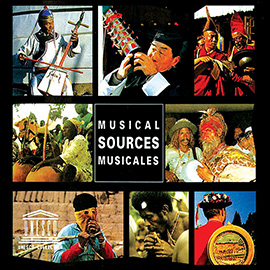-
UNESCO Collection Week 1 – Music as a Universal Language?
Starting today, Smithsonian Folkways begins releasing the extensive and influential UNESCO Collection of Traditional Music via digital download, streaming services, and on-demand physical CDs. Two albums will be released each week, complemented by a guest blog post, until all 127 albums—including 12 that were previously unreleased—become available.
Week One features Musical Sources and Dance and Festivity, two compilations drawn from the larger collection which serve as a perfect introduction to the series.
GUEST BLOG
by Georgia A. Newlin
I decided to listen to these two albums without first reading the liner notes. My intent was to experience the music aesthetically—to get a feel—and then listen again, intellectually, with notes in hand.
Listening to the Dance and Festivity album went smoothly, as upbeat tempi, polyrhythms, body percussion, quick instrumental lines, and harmonious voices all lent to the feel of being in a place where an event was being celebrated through music. The activity seemed to support the adage that music is a universal language. Regardless of whether or not I understood the lyrics or even knew what particular instrument was producing an interesting sound, I could feel that the music represented an occasion.
However, Musical Sources proved to be much more difficult for me to experience without liner notes, especially without having a theme in mind as with the title of the first recording. I sometimes couldn’t tell whether a slow song was mournful, contemplative, joyful, or sacred.
Listening to the second album belied the postulation that music is a universal language. For me, without contextual knowledge, there was no universal syntax for this varied music that allowed me to comprehend the meaning behind each particular piece. Scales and modes, rhythms, instruments, melodies, harmonies, textures, structural forms, meters, vocal timbres, dynamics, tempos, languages, and performance practices seem different for each musical selection.
Listen to a UNESCO sampler here.
Interestingly, however, while listening through both albums the second time with liner notes in hand, I was struck by the thought that, while not a universal language, music is a universal experience. We all live, celebrate, laugh, protest, mourn, dance, remember, teach, and love through music. Some mourn with stiff upper lips and others with wailing moans. Some protest with marches or confrontation, while others remain resolutely composed. Some pray sitting still with quiet responsorial music playing in the background, while others stand to sing, clap, move, and shout. Indeed, it is our universal experiencesfused with our individual differences that make listening to Dance and Festivity and Musical Sources so fascinating!
Dance and Festivity includes selections from 20 musical traditions, and the liner notes include information on cultural background, instruments, origin, performers, dances, celebrations, or symbolism for each song.
Musical Sources contains 30 selections, and the liner notes provide more detailed performer and instrument information for every piece, as well as photographs of the original album from which each of these tracks was taken. The musicians and their instruments are all displayed in beautiful color. In this way, meaning is added to the music.
Both of these recordings are samplers—each track is taken from another recording from the UNESCO collection that embodies a particular heritage, geographical location, festival, et cetera. I found myself absolutely drawn to music about which I know little or nothing. The difference in vocal timbres from around the world is amazing. The variety of ways of producing a unique sound from a hand-held drum is innumerable. The ways in which people from every livable location on the globe experience music appear to be completely divergent, and, yet, because of music being entwined with all facets of life for all people, a feeling of similarity can be shared.
Dance and Festivity and Musical Sources are a perfect pair of recordings for early release in the UNESCO Collection of Traditional Music. The varied tracks of music as well as the gorgeous photography will prompt people to dig further into each tradition, demonstrating that this 127-album collection is worthy of further exploration!
Georgia A. Newlin, DMA
Professor of Music Education, Adelphi University
Past President, Organization of American Kodály EducatorsUNESCO Collection Week 1 – Music as a Universal Language? | Smithsonian Folkways Recordings



